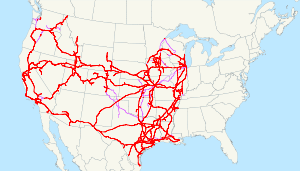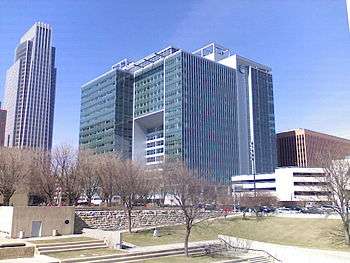Union Pacific Railroad
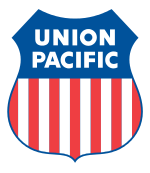 | |
|
System map (trackage rights in purple) | |
 | |
| Reporting mark | UP (road locomotives), UPY (yard locomotives), UPP (passenger railcars) |
|---|---|
| Locale | United States from Chicago, Illinois, and cities along the Mississippi River to the Pacific coast |
| Dates of operation | 1862–present |
| Track gauge | 4 ft 8 1⁄2 in (1,435 mm) standard gauge |
| Length | 32,100 miles (51,660 km) |
| Headquarters |
1400 Douglas Street Omaha, Nebraska |
| Website |
www |
The Union Pacific Railroad (reporting mark UP) is a freight hauling railroad that operates 8,500 locomotives over 32,100 route-miles in 23 states west of Chicago, Illinois and New Orleans, Louisiana. The Union Pacific Railroad network is the largest in the United States and employs 42,600 people. It is also one of the world's largest transportation companies.[1]
Union Pacific Railroad is the principal operating company of Union Pacific Corporation (NYSE: UNP); both are headquartered in Omaha, Nebraska. Over the years Union Pacific Corporation has grown by acquiring other railroads, notably the Missouri Pacific, Chicago & North Western, Western Pacific, Missouri-Kansas-Texas, and the Southern Pacific (including the Denver & Rio Grande Western).
Union Pacific Corporation's main competitor is the BNSF Railway, the nation's second largest freight railroad, which also primarily services the Continental U.S. west of the Mississippi River. Together, the two railroads have a duopoly on all transcontinental freight rail lines in the U.S.
The current chairman of Union Pacific Corporation is Lance Fritz.[2]
History
The original company was incorporated on July 1, 1862, under an act of Congress entitled Pacific Railroad Act of 1862. The act was approved by President Abraham Lincoln, and it provided for the construction of railroads from the Missouri River to the Pacific as a war measure for the preservation of the Union.[3] It was constructed westward from Council Bluffs, Iowa to meet the Central Pacific Railroad line, which was constructed eastward from San Francisco Bay.
The line was constructed primarily by Irish labor who had learned their craft during the recent Civil War.[4] The two lines were joined together at Promontory Summit, Utah, 53 miles (85 km) west of Ogden on May 10, 1869, hence creating the first transcontinental railroad in North America.[5] Under the guidance of its dominant stockholder Dr. Thomas Clark Durant, the namesake of the city of Durant, Iowa, the first rails were laid in Omaha.
Subsequently, UP purchased three Mormon-built roads: the Utah Central Railroad extending south from Ogden to Salt Lake City, the Utah Southern Railroad extending south from Salt Lake City into the Utah Valley, and the Utah Northern Railroad extending north from Ogden into Idaho. It built or purchased local lines that gave it access to Denver, Colorado, to Portland, Oregon, and to the Pacific Northwest and acquired the Kansas Pacific (originally called the Union Pacific, Eastern Division, though in essence a separate railroad). It also owned narrow gauge trackage into the heart of the Colorado Rockies and a standard gauge line south from Denver across New Mexico into Texas (both parts of the Union Pacific, Denver and Gulf Railway).

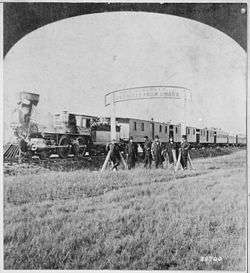
UP was entangled in the Crédit Mobilier scandal, exposed in 1872. Its independent construction company the Crédit Mobilier had bribed congressmen. The UP itself was not guilty but it did get bad publicity. The financial crisis of 1873 led to financial troubles but not bankruptcy. The company was reorganized as the Union Pacific Railway on January 24, 1880, with its dominant stockholder being Jay Gould. The new company declared bankruptcy during the Panic of 1893. When it emerged in 1897 it reverted to the original name, Union Pacific Railroad.[6]
The corporate headquarters of the Union Pacific Corporation were located in New York City from its initial founding in the 1860s until Drew Lewis became CEO in the mid-1980s. He relocated it to Bethlehem, Pennsylvania. Later the headquarters was shifted to Dallas, Texas, before relocating to Omaha to join the operating headquarters.[7]
| Year | Traffic |
|---|---|
| 1925 | 1,065 |
| 1933 | 436 |
| 1944 | 5,481 |
| 1960 | 1,233 |
| 1970 | 333 |
In the tables "UP" includes OSL-OWR&N-LA&SL-StJ&GI; 1925–1944 passenger-mile totals do not include Laramie North Park & Western, Saratoga & Encampment Valley, or Pacific & Idaho Northern, and none of the totals includes Spokane International or Mount Hood. From the ICC annual reports, except 1979 is from Moody's.
| UP | LNP&W | S&EV | P&IN | |
|---|---|---|---|---|
| 1925 | 12,869 | 10 | 3 | |
| 1933 | 8,639 | 4 | 0.4 | (into UP) |
| 1944 | 37,126 | 7 | 0.7 | |
| 1960 | 33,280 | (into UP) | (into UP) | |
| 1970 | 47,575 | |||
| 1979 | 73,708 |
On December 31, 1925 UP-OSL-OWRN-LA&SL-StJ&GI operated 9,834 route-miles and 15,265 track-miles. At the end of 1980, Union Pacific operated 9,266 route-miles and 15,647 miles of track.[8] Moody's shows 220,697 million revenue ton-miles in 1993 on the expanded system (17,835 route-miles at the end of the year).
Union Pacific Corporation
 | |
| Public | |
| Traded as |
NYSE: UNP DJTA Component S&P 100 Component S&P 500 Component |
| Industry | Transportation |
| Founded | Omaha, Nebraska, United States (1862) |
| Headquarters | Omaha, Nebraska, United States |
Area served | Western and Mid-Western United States |
Key people |
|
| Revenue | |
| Total assets | |
| Total equity | |
Number of employees | 42,884 (2010)[11] |
| Subsidiaries |
[11]:at Exhibit 21
|
| Website |
www |
|
Footnotes / references [11] | |
Union Pacific Corporation is the publicly traded parent company of all UP subsidiaries and operating companies, including Union Pacific Railroad Company (the largest operating company) and Southern Pacific Rail Corporation. Union Pacific Corporation was incorporated in Utah in 1969.[11] Union Pacific Corporation's headquarters are located in Omaha, Nebraska. Lance M. Fritz is the current Chairman, President and Chief Executive Officer.
Facilities
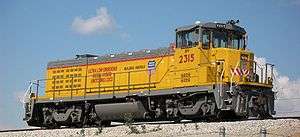
Because of the large size of UP, hundreds of yards throughout its rail network are needed to effectively handle the daily transport of goods from one place to another. To reduce overall emissions, Union Pacific is acquiring a new generation of environmentally friendly locomotives for use in Los Angeles basin rail yards.
Union Pacific built a $90 million state-of-the-art intermodal terminal in San Antonio Intermodal Terminal in San Antonio, Texas in 2009.[13][14]
Active hump yards
Hump yards work by using a small hill over which cars are pushed, before being released down a slope and switched automatically into cuts of cars, ready to be made into outbound trains. Union Pacific's active hump yards include:[15]
- Bailey Yard in North Platte, Nebraska
- Beaumont Yard in Beaumont, Texas
- Davidson Yard in Fort Worth, Texas
- Davis Yard in Roseville, California
- Englewood Yard in Houston, Texas
- Gateway Yard in East St Louis, Illinois, owned by subsidiary Alton and Southern Railway
- Hinkle Yard in Hermiston, Oregon
- Livonia Yard in Livonia, Louisiana
- Neff Yard in Kansas City, Missouri
- North Little Rock Yard in North Little Rock, Arkansas
- Pine Bluff Yard in Pine Bluff, Arkansas
- Proviso Yard in Northlake, Illinois, formerly owned by Chicago and North Western Transportation Company
- Strang Yard in La Porte, Texas
- West Colton Yard in Bloomington, California
Union Pacific Railroad Museum

The Union Pacific Railroad Museum in Council Bluffs, Iowa, houses one of the oldest corporate collections in the United States. It includes artifacts, photographs, and documents that trace the development of the railroad and the American West.
The completion of Union Pacific’s transcontinental railroad in 1869 helped shape the landscape and geography and brought tens of thousands of westward-bound immigrants to the American West.
The museum’s collection features weapons from the late 19th and 20th centuries, outlaw paraphernalia, a sampling of the immigrants’ possessions, and a photograph collection comprising more than 500,000 images.[16]
In 2009, the America’s Power Factuality Tour stopped at the Union Pacific Railroad Museum to report on the railroad’s role in generating electricity in the United States.[17]
Locomotive and rolling stock
Paint and colors

UP's basic paint scheme for its diesel-electric locomotives is the oldest still in use by a major railroad. The middle two-thirds of the locomotive body is painted Armour Yellow, so-named because it was the color used by the Armour meat company. A thin band of Signal Red divides this from the Harbor Mist Gray (a fairly light gray) used for the body and roof above that point. Signal Red is also painted at the bottom of the locomotive body, but this color has gradually become yellow as new Federal Railroad Administration (FRA) regulations for reflectorized tape came into effect in 2005; the trucks, underframe, fuel tanks and everything else beneath that line are also Harbor Mist Gray. Lettering and numbering are in Signal Red, with black outlines. Some locomotives (historically passenger locomotives, and some recent units from 2000 on) have white-outlined blue "wings" on the nose. Beginning in early 2002, a number of units were repainted with a large, billowing American flag with the corporate motto "Building America" on the side, where the 'UNION PACIFIC' lettering is normally positioned. This paint scheme is known as "Building America," "Wings," or "Flags and Flares."
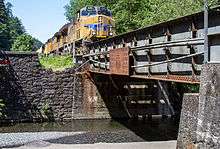
The Armour Yellow livery was first introduced on the UP's M-10000 streamliner train in 1934, although Leaf Brown was used instead of Harbor Mist Grey. Passenger cars, cabooses, and other non-freight equipment have also been painted in a similar fashion.
The steam locomotive paint schemes are unique in their own way. Up until the mid-1940s, all steam locomotives on UP were painted in a standard scheme: the smokebox and firebox were painted graphite and the rest was painted jet black; the lettering was usually aluminum. In the late 1940s, many passenger steam locomotives were repainted in a two-tone grey scheme to match the scheme applied to some coaching stock. These locomotives were painted light grey, with one dark gray strip running from front to rear alongside the running board and in the middle of the tender. This dark grey strip was outlined in yellow (originally aluminum), and all lettering inside the strip was yellow also. After 1952, these locomotives were repainted in the same basic black color scheme as the earlier freight locomotives. The grey passenger cars were repainted in the yellow scheme.
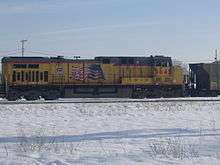
From the second half of 2005 to the summer of 2006, UP unveiled a new set of six EMD SD70ACe locomotives in "Heritage Colors," painted in schemes reminiscent of railroads acquired by UP since the 1980s. The engine numbers match the year that the predecessor railroad was absorbed into Union Pacific. The locomotives commemorate the Missouri Pacific with UP 1982, the Western Pacific with UP 1983, the Missouri-Kansas-Texas with UP 1988, the Chicago and North Western with UP 1995, the Southern Pacific with UP 1996, and the Denver and Rio Grande Western with UP 1989. Although the Denver and Rio Grande Western was not a direct predecessor because it had purchased the SP in 1988 but kept the larger system's name, the Union Pacific still included it in the heritage series.[18]
In October 2005, UP unveiled another specially painted SD70ACe: 4141 has "George Bush 41" on the sides and its paint scheme resembles that of Air Force One.
On March 31, 2010, UP dedicated a specially painted GE ES44AC locomotive commemorating the centennial of the Boy Scouts of America.[19] Although it retains the standard Armour Yellow and Harbor Mist colors, the unit has a large BSA 2010 logo on each side of the long hood, and the scouting logo low on the side of the cab.
On September 28, 2010, UP dedicated a specially painted GE ES44AC locomotive, as a tribute to Susan G. Komen for the Cure.[20] The unit is standard UP Armour Yellow and Harbor Mist colors, but has a large pink ribbon, the symbol for breast cancer awareness, on each side of the long hood.
2013 locomotive roster
As of October 2013, the Union Pacific had 8,185 locomotives on its active roster. The locomotive fleet consists of 42 different models and had an average age of 17.8 years.[21]
| Type | Quantity |
|---|---|
| 4-8-8-4 | 1 |
| 4-6-6-4 | 1 |
| 4-8-4 | 1 |
| B40-8 | 91 |
| C40-8 | 333 |
| C40-8W | 50 |
| C41-8W | 154 |
| C4460AC | 80 |
| C44-9W | 274 |
| C44AC/CTE | 1,485 |
| C45AC/CTE | 943 |
| C6044AC | 176 |
| C60AC | 75 |
| DDA40X | 1 |
| E9A | 2 |
| E9B | 1 |
| GP15-1 | 160 |
| GP38-2 | 664 |
| GP38AC | 2 |
| GP39-2 | 49 |
| GP40 | 15 |
| GP40-2 | 142 |
| GP40-2P | 2 |
| GP40M-2 | 65 |
| GP50 | 48 |
| GP60 | 194 |
| MP15AC | 41 |
| MP15DC | 102 |
| SD40-2 | 505 |
| SD60 | 85 |
| SD60M | 560 |
| SD70ACe | 321 |
| SD70M | 1,445 |
| SD9043AC | 309 |
| SW1500 | 18 |
Surviving merger partner locomotives

As of May 23, 2015, UP operates 9 Southern Pacific (107,177,187, 266, 309, 319, 335, 343, and 352) 2 St. Louis Southwestern (9642, and 9708), and 2 Chicago and North Western (8646 and 8701) locomotives that are still in the former railroads' paint. In addition, many locomotives have been "patched" and renumbered by UP, varying in the degree of the previous railroads' logos being eradicated, but always with a yellow patch applied over the locomotive's former number and a new UP number applied on the cab. This allows UP to number locomotives into its roster, yet it takes less time and money than it does to perform a complete repaint into UP colors. As of May 17, 2015, UP rostered 212 "patches", consisting of:
- 22 Chicago and North Western (whose CNW logos have been hidden by the "patches"),
- 174 Southern Pacific (AC4400CW, GP40-2, MP15AC, and GP60)
- 14 St. Louis Southwestern (GP60)
- 2 Denver and Rio Grande Western (GP60)
While not technically a predecessor locomotive in the traditional sense, UP rosters a single SD40-2 (3564) still in the 1970s paint scheme. Also, several patched units have uniquenesses, such as UP 6289 (The 'flaming' patch), and UP 6361 (SP paint, with full UP letters on conductor's side). UP also rosters an ex-CNW AC4400CW in UP paint, that has been decaled with 'We Will Deliver' and Operation Lifesaver (6736). UP retains many CNW units with OLS decals.
Historic locomotives
Alone among modern railroads, UP maintains a small fleet of historic locomotives for special trains and hire in its Cheyenne, Wyoming roundhouse.
- UP 4014 is a 4-8-8-4 Articulated type, Big Boy, freight steam locomotive. On July 23, 2013, it was announced that the UP was acquiring UP 4014 from The Southern California Chapter of The Railway and Locomotive Historical Society in Pomona, with the goal of restoring it to service. 4014 was moved from Pomona to the Union Pacific West Colton yard on January 26, 2014 and then to Cheyenne, Wyoming. Restoration to full operating condition is currently in progress, expected to be finished between 2017 and 2019. Volunteers and paid contractors are assisting the UP steam crew in the rebuild predominantly at the UP Steam Shop in Cheyenne.[22]
- UP 844 is a 4-8-4 Northern type express passenger steam locomotive (class FEF-3). It was the last steam locomotive built for UP and has been in continuous service since its 1944 delivery. Many people know the engine as the No. 8444, since an extra '4' was added to its number in 1962 to distinguish it from a diesel numbered in the 800 series. This diesel locomotive is now in service at the Nevada Southern Railroad Museum in Boulder City, Nevada. It regained its rightful number in June 1989, after the diesel was retired. A mechanical failure occurred on June 24, 1999, in which the boiler tubes from the 1996 overhaul, being made of the wrong material, collapsed inside the boiler and put the steam locomotive out of commission. The UP steam crew successfully repaired it and returned it to service on November 10, 2004. It is currently going under a 15-year inspection and should return to service by 2016. It is the only steam locomotive to never be officially retired from a North American Class I railroad.
- UP 3985 is a 4-6-6-4 Challenger class dual-service steam locomotive. It is the largest steam locomotive still in operation anywhere in the world. Withdrawn from service in 1962, it was stored in the UP roundhouse until 1975, when it was moved to the employees' parking lot outside the Cheyenne, Wyoming, depot until 1981 when a team of employee volunteers restored it to service. In 2007, it underwent repairs for service, and was back up and running in 2008 to continue its run. UP 3985 has been in storage since 2010, but may return to service once 4014's restoration is completed.
- UP 951, 949 and 963B are a trio of streamlined General Motors Electro-Motive Division E9 passenger locomotives built in 1955. They are used to haul the UP business cars and for charter specials. While externally they are 1955 vintage locomotives, the original twin 1200 hp 12-cylinder 567 series engines have been replaced with single EMD 16-645E 2000 hp (1.5 MW) engines and the electrical and control equipment similarly upgraded, making them more modern locomotives under the skin. Some refer to the units as "E38-2" units, as the internal equipment was taken from wrecked GP38-2 locomotives. The set is made of two A units and one B unit. The B unit contains an HEP engine-generator set for powering passenger cars. The two A units were recently modified to eliminate the nose doors to increase safety in the event of collision.
- UP 6936 is an EMD DDA40X "Centennial" diesel-electric locomotive. These were the largest diesel locomotives ever built and were manufactured specifically for UP.
- UP 5511 is a 2-10-2 steam locomotive. This locomotive is very rarely ever heard of, because it was never donated for public display. This locomotive is reportedly in excellent condition. The only thing keeping it from being restored is that it would be limited to 40 mph (64 km/h) or lower due to its large cylinders and small drivers. As of August 2004, this locomotive is being offered for sale by UP. It is currently in storage at the roundhouse where 844 & 3985 are repaired in Cheyenne, Wyoming
- UP 1243 is a 4-6-0 steam locomotive, and is the oldest locomotive owned by UP. Built in 1890 and retired in 1957, it was at first stored in Rawlins, Wyoming. It was cosmetically restored in 1990 for public display, and toured with 844 as part of the Idaho and Wyoming Centennial train, being moved on a flat car. It was moved to Omaha, Nebraska in November 1996 and put on display at the Western Heritage Museum.
In addition there are a number of other locomotives kept in storage for possible future restoration. Rio Grande (DRGW) F9B 5763 is one of the units in storage, part of the Trio (A-B-B) of F9s that served on the Rio Grande in various Passenger Duty services (From the Denver Ski Train to the Zephyr Trains) until their retirement in 1996. Sister Units 5771 (F9A) and 5762 (F9B) were donated to the Colorado Railroad Museum. Chicago and North Western F7 No. 401, used for Chicago and North Western business trains, also was retained by UP.
UP 838, a twin to 844, is stored in the Cheyenne roundhouse as a parts source, though as most of its usable parts have already been applied to 844, it is more likely to see use as a source of pattern parts for reproduction replacements. Reputedly, 838's boiler is in better condition than that of 844, due to 838 having not been in steam since retirement, compared to 844's relatively heavy use since 1960.
Among the former tenants was Southern Pacific 1518 (the first production SD7 ex EMD demo 990), transferred to the Illinois Railway Museum after some time in storage in the UP shops.
Preserved steam locomotives
In addition to the historic fleet outlined above kept by UP itself, a large number of UP locomotives survive elsewhere. Many locomotives were donated to towns along the Union Pacific tracks, for instance, as well as locomotives donated to museums.
- UP 18, 26. From 1948 to 1970, UP operated a series of Gas turbine-electric locomotives. No other railroad in the world operated turbines on such a scale. At one point, UP claimed that the turbines hauled 10% of its freight. These were ultimately retired due to rising fuel costs. Two surviving GTELs can be seen on display; UP 18 is at the Illinois Railway Museum in Union, Illinois, and UP 26 is displayed at the Utah State Railroad Museum in Ogden, Utah.
- UP 407 – A 2-8-0 type, donated to City of Sidney, Nebraska in July 1956
- UP 421 – A 2-8-0 type, donated to City of Fairbury, Nebraska in April 1956
- UP 423 – A 2-8-0 type, donated to City of Gering, Nebraska in July 1955
- UP 428 – A 2-8-0 type, undergoing restoration at the Illinois Railway Museum, Union, Illinois
- UP 437 – A 2-8-0 type, donated to City of Grand Island, Nebraska in September 1955
- UP 440 – A 2-8-0 type, donated to City of Lincoln, Nebraska in May 1955, moved to Mid-Continent Railway Museum, North Freedom, Wisconsin in June 1975
- UP 460 – A 2-8-0 type, donated to City of Marysville, Kansas in April 1956
- UP 477 – A 2-8-0 type, donated to City of Salina, Kansas in July 1955
- UP 480 – A 2-8-0 type, donated to City of North Platte, Nebraska in February 1956
- UP 481 – A 2-8-0 type, on display at Buffalo County Historical Society, Kearney, Nebraska
- UP 485 – A 2-8-0 type, donated to City of Lexington, Nebraska in June 1956
- UP 529 – A 2-8-0 type, on display at Northwest Railway Museum, Snoqualmie, Washington
- UP 533 – A 2-8-0 type, donated to City of Rawlins, Wyoming in December 1958
- UP 561 – A 2-8-0 type, on display at Pawnee Park, Columbus, Nebraska
- UP 616 – A 2-8-0 type, donated to City of Nampa, Idaho in August 1958
- UP 618 – A 2-8-0 type, at the Heber Valley Historic Railroad
- UP 737 – A 4-4-0 type, was in the collection of Steamtown National Historic Site, then moved to Feather River Railroad Museum, Portola, California. Currently displayed at the Double-T Agricultural Museum in Stevinson, California.
- UP 119 – A 4-4-0 type, the original was scrapped, and thus technically does not count as a preserved engine. However, a full-scale, exact replica was built in 1979, and currently operates at the Golden Spike National Historic Site in Promontory, Utah.
- UP 814 – A 4-8-4 type, on display at Dodge Park, Council Bluffs, Iowa
- UP 833 – A 4-8-4 type, on display at Eccles Rail Center, Utah State Railroad Museum Union Station, Ogden, Utah
- UP 942 - An EMD E8 type, on display and operation use at the Orange Empire Railroad Museum
- UP 1242 – A 4-6-0 type, on display at Lions Park, Cheyenne, Wyoming
- UP 2005 – A 2-8-2 type, on display at Ross Park, Pocatello, Idaho
- UP 2295 – A 2-8-2 type, on display at former UP passenger depot, Boise, Idaho
- UP 2537 – A 2-8-2 type, donated to City of Walla Walla, Washington in December 1959
- UP 2564 – A 2-8-2 type, originally on display in Oro Grande, California, May 1959, then moved to Orange Empire Railway Museum, Perris, California
- UP 3203 – A 4-6-2 type, donated to City of Portland, Oregon in January 1958. Originally Oregon Railway and Navigation Company No. 197, it was moved to the Brooklyn Roundhouse in 1996 and to the Oregon Rail Heritage Center in 2012, where it is now undergoing restoration.
- UP 3206 – A 4-6-2 type, originally on display at Highbridge Park in Spokane, Washington. Moved to Spokane Interstate Fairgrounds in 1978.
- UP 3977 is the only 4-6-6-4 Challenger class dual-service steam locomotive on static display. It is located in Cody Park in North Platte, Nebraska.
- UP 4004 – A Union Pacific Big Boy 4-8-8-4 articulated steam locomotive, on display in Holiday Park, Cheyenne, Wyoming
- UP 4005 – A Union Pacific Big Boy 4-8-8-4 articulated steam locomotive, on display at Forney Museum of Transportation, Denver, Colorado
- UP 4006 – A Union Pacific Big Boy 4-8-8-4 articulated steam locomotive, on display at National Museum of Transport, St. Louis, Missouri
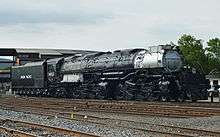
- UP 4012 – A Union Pacific Big Boy 4-8-8-4 articulated steam locomotive, originally on display at Bellows Falls, Vermont, moved to Steamtown, Scranton, Pennsylvania in 1984[23]
- UP 4014 – A Union Pacific Big Boy 4-8-8-4 articulated steam locomotive, was on display at Los Angeles County Fair Grounds, Pomona, California. Is now in the process of being restored for excursion service in Cheyenne, Wyoming. In July 2013, UP announced that it is acquiring 4014 to restore it for use again. Although the restoration will take several years to complete, UP thinks that they can have the locomotive ready by 2019 for the 150th Anniversary of the driving of the Golden Spike.
- UP 4017 – A Union Pacific Big Boy 4-8-8-4 articulated steam locomotive, on display at National Railroad Museum, Green Bay, Wisconsin
- UP 4018 – A Union Pacific Big Boy 4-8-8-4 articulated steam locomotive, originally on display at Texas State Fair Grounds, Dallas, Texas. Number 4018, currently residing at the Museum of the American Railroad in Dallas, TX, almost saw a return to operation in 1998 when a film director proposed restoring the locomotive for use in a movie. However, it has been 9 years since anything has been heard of this proposal, and it is considered to have been only a whim.
- UP 4023 – A Union Pacific Big Boy 4-8-8-4 articulated steam locomotive, on display at Lauritzen Gardens/Kenefick Park, Omaha, Nebraska
- UP 4420 – An 0-6-0 type, donated to City of Evanston, Wyoming, in June 1958
- UP 4436 – An 0-6-0 type, on display at Eccles Rail Cener, Utah State Railroad Museum Union Station, Ogden, Utah
- UP 4439 – An 0-6-0 type, on display at Griffith Park, Los Angeles
- UP 4442 – An 0-6-0 type, donated to City of Las Vegas, Nevada, in April 1960, since moved to Henderson, Nevada
- UP 4455 – An 0-6-0 type, operated by the Laramie Portland Cement plant hauling limestone from the quarry southwest of Laramie, Wyoming until 1965, then to Colorado Railroad Museum for display
- UP 4466 – An 0-6-0 type built by Lima Locomotive Works in 1920, displayed at the California State Railroad Museum. It operated at the museum until 1999.
- UP 6051 – A 2-8-0 type, on display at Fairmount park, Riverside, California
- UP 6072 – A 2-8-0 type, on display at Ft. Riley Museum, Ft. Riley, Kansas
- UP 6237 – A 2-8-0 type, donated to City of Hastings, Nebraska in July 1956
- UP 6264 – A 2-8-0 type, on display at Nevada Southern Railroad Museum, Boulder City, Nevada
- UP 6535 – A 2-8-0 type, on display at Depot Park, Laramie, Wyoming
- UP 6900 Centennial series – Several of the huge DDA40X diesel-electric locomotives have been saved. Other than 6936 that UP maintains in its heritage fleet, none of the remaining Centennials operate. However, 6930 at the Illinois Railway Museum has operating cab controls, allowing it to couple to another locomotive and control it.
- UP 9000, a Union Pacific 9000 class 4-12-2 giant non-articulated freight locomotive, at the Fairplex in Pomona, California
Passenger train service
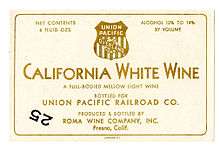
Union Pacific operated through passenger service over its historic "Overland Route" between 1869 until May 1, 1971. The last passenger train operated by UP was the westbound City of Los Angeles. After May 1, 1971, Amtrak assumed operation of long-distance passenger operations in the United States. UP at various times operated the following named passenger trains:
- Butte Special (operated between Salt Lake City and Butte, Montana)
- Challenger (operated jointly with the Chicago and North Western Railway until October 1955, and thereafter the Milwaukee Road)
- City of Denver (operated jointly with the Chicago and North Western Railway until October 1955, and thereafter the Milwaukee Road)
- City of Las Vegas; later, the Las Vegas Holiday Special (1956–1967)
- City of Los Angeles (operated jointly with the Chicago and North Western Railway until October 1955, and thereafter the Milwaukee Road)
- City of Portland (operated jointly with the Chicago and North Western Railway until October 1955, and thereafter the Milwaukee Road)
- City of Salina (1934–1940)
- City of San Francisco (operated jointly with the Chicago and North Western Railway and the Southern Pacific Railroad; after October, 1955 the Milwaukee Road assumed operation of the Chicago-Omaha leg of the service)
- City of St. Louis
- Columbine (in service to Chicago and Denver, beginning in the 1920s)
- Forty-Niner (operated between Chicago and Oakland)
- Gold Coast (operated between Chicago and Oakland/Los Angeles)
- Idahoan (operated between Cheyenne and Portland)
- Los Angeles Limited (in service 1905)
- Overland Flyer; renamed the Overland Limited in 1890 (1887–1963)
- Pacific Limited (operated between Chicago and Ogden, Utah where it was split to serve Los Angeles and San Francisco, beginning in 1913. It was combined with the Portland Rose in 1947.)[24]
- Pony Express (operated between Kansas City and Los Angeles 1926—1954)
- Portland Rose (in service between Chicago and Portland, beginning in the 1920s)[25]
- San Francisco Overland (originally operated between Chicago and Oakland, later terminated only at St. Louis)
- Spokane (operated between Spokane and Portland)
- Utahn (operated between Cheyenne and Los Angeles)
- Yellowstone Special (operated between Pocatello, Idaho and West Yellowstone, Montana)
UP mainly operates commuter trains for Metra on the Union Pacific Lines: Union Pacific/North Line, Union Pacific/Northwest Line, and Union Pacific/West Line.
Many Amtrak routes currently utilize Union Pacific rails:
- Amtrak Cascades
- California Zephyr
- Capitol Corridor
- Cardinal
- Coast Starlight
- Hoosier State
- Lincoln Service
- Missouri River Runner
- Pacific Surfliner
- San Joaquin
- Sunset Limited
- Texas Eagle
Notable accidents

On June 28, 2004, in the San Antonio suburb of Macdona, Texas, a UP train collided with an idle BNSF train resulting in the puncturing of a 90-ton tank car carrying liquified chlorine. As the chlorine vaporized, a toxic "yellow cloud" soon formed which killed three (the UP conductor and two residents nearby) and caused 43 hospitalizations. The costs of cleanup and property damaged during the incident exceeded $7 million.[26]
Another derailment in November 1994 killed a bystander in a neighboring business in San Antonio. Senator Kay Bailey Hutchison demanded a federal investigation in the Union Pacific crashes around Bexar County.[27] In March 2005, Texas Governor Rick Perry supported a plan to reroute trains around large urban population centers in the state of Texas, including San Antonio.[28]
Various investigations of the Macdona incident have revealed several serious safety lapses on the part of the Union Pacific and its employees; specifically, Federal Railroad Administration (FRA) officials in 2004 reported that the Union Pacific had "notable deficiencies", including its employees not following the company's own safety rules.[29] While initial reports blamed "fatigue" of the crew of the UP train, many other contributing factors have been cited. Among those, the chlorine tank cars were improperly placed near the front of the train.[30] Cars containing hazardous materials have traditionally been placed away from the front of the train, an operational measure used to safeguard against the likelihood of the such cars being among the first affected in a derailment and to reduce their likelihood of colliding with heavier steel cars.
On September 4, 2007 a Union Pacific train derailment split the small town of Sergeant Bluff, Iowa, in half. Around 16 cars, most of them carrying salt, derailed spilling its contents in mountainous, snow-like piles. The derailment caused an interruption in traffic for about two hours until city officials could clean up the mess[31]
In the aftermath of the Macdona and other incidents, the Federal Railroad Administration signed a compliance agreement with the railroad in November 2004 in which the railroad promised to rectify the "notable deficiencies" that regulators found.[28][29] Specifically, the agreement mandated increased training for railroad managers and increased the number of FRA inspectors in the region by 10.[29] United States Assemblyman Charlie Gonzalez questioned if the agreement went far enough; he and other Congressional delegation members questioned the FRA's "partnership" approach as being "too cozy a relationship to the railroads" and cited an article in The New York Times that reported that the acting FRA administrator, Betty Monro, and the chief lobbyist for Union Pacific, Mary E. McAuliffe, had vacationed several times together on Nantucket.[29]
The railroad's San Antonio Service Unit (SASU) has had other derailments,[32][33][34][35] including a Schulenburg, Texas incident in June 2009 where tank cars containing chlorine and petroleum naptha xylene derailed but were not punctured.[36]
On January 7, 2008, a Union Pacific train carrying hazardous materials was derailed by a tornado near Lawrence, Illinois, injuring five and prompting a local evacuation. The train's rear surveillance camera caught the derailment on video.[37]

On June 24, 2012, three crew members were killed when two Union Pacific trains slammed into each other just east of Goodwell, about 300 miles northwest of Oklahoma City. The eastbound train passed a signal displaying stop on the main track striking the westbound train which was lined into the siding about 1 mile east of the meeting point. The crash triggered a diesel-fueled fireball that appeared to weld the locomotives together.[38]
On November 15, 2012, the Midland train crash occurred, in which four United States military veterans were killed when their parade float was struck by a train in Midland, Texas.
On May 25, 2013, in Chaffee, Missouri, a Union Pacific train collided with a BNSF train at a level junction. Seven people were injured. A total of 24 cars were derailed, including loaded autorack and scrap metal cars. Included in the crash were two Union Pacific engines. The accident caused an overpass to partially collapse, and a post-accident fire was also reported.[39][40] The resulting investigation concluded the engineer most likely fell asleep, due to sleep apnea. In this, four progressively restrictive signals where violated, resulting in the UP train hitting the BNSF train at roughly 40 MPH. Total damages exceeded ten million dollars. The Missouri Route M bridge was reopened in August, 2013 with a new design.[41] [42]
On June 3, 2016, a 96-car oil train derailed in the Columbia River Gorge near Mosier, Oregon. 11 cars derailed and at least one caught on fire. 42,000 gallons of Bakken crude oil spilled of which 10,000 gallons was recovered. Some oil went into the Colombia River. Cleanup and investigations continue as of June 6.
Facts and figures

According to UP's 2007 Annual Report to Investors, at the end of 2007 it had more than 50,000 employees, 8,721 locomotives, and 94,284 freight cars.
Broken down by specific type of car, owned and leased:
- 35,437 covered hoppers
- 12,272 boxcars
- 18,647 open-top hoppers
- 13,780 gondolas
- 14,148 "other" types of cars
In addition, it owns 6,950 different pieces of maintenance of way work equipment. At the end of 2007 the average age of UP's locomotive fleet was 14.8 years, the freight car fleet 28 years.
Company officers
Presidents of the Union Pacific Railroad:
- William Butler Ogden (1862–1863)
- John Adams Dix (1863–1865)
- Oliver Ames, Jr. (1866–1871)
- Thomas Alexander Scott (1871–1872)
- Horace F. Clark (1872–1873)
- John Duff (1873–1874)
- Sidney Dillon (1874–1884)
- Charles F. Adams (1884–1890)
- Sidney Dillon (1890–1892)
- S.H.H. Clark (1890–1898)
- W.S. Pierce (acting) (1897)
- Horace G. Burt (1898–1904)
- E. H. Harriman (1904–1909)
- Robert S. Lovett (1910–1911)
- A.L. Mohler (1911–1916)
- E.E. Calvin (1916–1918)
- C.B. Seger (1918–1919)
- Carl R. Gray (1920–1937)
- William M. Jeffers (1937–1946)
- G.F. Ashby (1946–1949)
- Arthur E. Stoddard (1949–1965)
- E.H. Bailey (1965–1971)
- John Kenefick (1971–1986)
- Drew Lewis (1986–1987)
- Mike Walsh (1987–1991)
- Richard K. Davidson (1991–1996)
- Ron Burns (several months in 1996)
- Jerry Davis (1996–1998)
- Ike Evans (1998–2004)
- James R. Young (2004–2012)
- Jack Koraleski (2012–2015)
- Lance Fritz (2015–present)
Chief Executive Officers, Presidents, and Chairmen of the Union Pacific Corporation:
- James Evans (1969 - 1977)
- William Cook (1977 - 1987)
- John Kenefick (several months in 1986)
- Drew Lewis (1987–1997)
- Richard K. Davidson (1997 – January 2006)
- James R. Young (January 2006 – 2012)
- Jack Koraleski (2012–2015)
- Lance Fritz (2015–present)
Environmental record
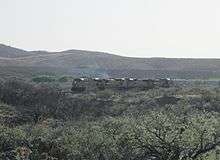
In Eugene, Oregon, the UP and the Oregon Department of Environmental Quality are jointly studying ground contamination at the railroad's yard originating with the Southern Pacific from over one hundred years ago, consisting mostly of petroleum hydrocarbons, industrial solvents, and metals. This has affected a nearby groundwater source.[43]
Union Pacific Railroad in 2007 started an experimental method of reducing emissions from the engine exhaust of their locomotives. By adding an experimental oxidation catalyst filtering canister to the diesel engine's exhaust manifold, they are attempting to reduce the amount of unburned hydrocarbons, carbon monoxide and particulate matter generated, much like a catalytic converter in automobiles and trucks. The United States Environmental Protection Agency’s National Vehicle Fuels and Emissions Laboratory provided most of the funding for the test. Using Ultra Low Sulfur diesel with the oxicat resulted in reduced particulate emissions by approximately 50 percent, unburned hydrocarbons by 38 percent and carbon monoxide by 82 percent.[44]
The company's Fuel Master program uses the expertise of locomotive engineers to save fuel. Engineers who save the most fuel are rewarded on a monthly basis. The program has saved the company millions of dollars, a significant amount of which has been returned to the engineers. In 2006, the program founder, Wayne Kennedy, received the John H. Chafee Environmental Award, and the program was recognized by Secretary of Transportation Norman Mineta.[45]
EMP

EMP, a domestic interline Intermodal freight transport partnership that provides shipping and logistics of containers, is owned by Union Pacific, along with Norfolk Southern Railroad and agent-owned partners Canadian National Railway, Canadian Pacific Railway, I&M Rail Link, Iowa Interstate Railroad, Wisconsin Central Ltd., and Kansas City Southern Railway. EMP's fleet of more than 35,000 domestic 53-foot containers and chassis traverse major cities throughout North America.[46][47][48] ![]()
See also
- Central Pacific Railroad
- Control Car Remote Control Locomotive (ex-locomotives used by the UP for remote control)
- First Transcontinental Railroad
- Hell on Wheels (TV series involving Union Pacific set in 1865)
- History of rail transportation in California
- Kansas Pacific Railway
- Los Angeles and Salt Lake Railroad
- Missouri–Kansas–Texas Railroad
- Missouri Pacific Railroad
- Pacific Fruit Express
- Railex
- Renzenberger, Inc.
- Southern Pacific Transportation Company
- Western Pacific Railroad
- Yule Marble
Notes
- ↑ "Company Overview". UP.com. Union Pacific Corporation. 31 December 2013. Retrieved 27 March 2014.
- ↑ "Union Pacific Corporation Elects David B. Dillon to Board of Directors, Names CEO Lance Fritz Chairman". Union Pacific Corporation. Retrieved 1 April 2014.
- ↑ "An Act to aid in the construction of a railroad and telegraph line from the Missouri river to the Pacific ocean, and to secure to the government the use of the same for postal, military, and other purposes Archived May 27, 2016, at the Wayback Machine. 12 Stat. 489, July 1, 1862
- ↑ Collins, R.M. (2010). Irish Gandy Dancer: A tale of building the Transcontinental Railroad. Seattle: Create Space. p. 198. ISBN 978-1-4528-2631-8.
- ↑ "Ceremony at "Wedding of the Rails," May 10, 1869 at Promontory Point, Utah". World Digital Library. 1869-05-10. Retrieved 2013-07-20.
- ↑ Brian Solomon (2000). Union Pacific Railroad. Voyageur Press. pp. 35–43.
- ↑ UP:Chronological History Archived August 10, 2006, at the Wayback Machine., Union Pacific Railroad
- ↑ 1980 mileage is from Moody's Transportation Manual (1981); the ICC's Transport Statistics says Union Pacific System operated 8,614 route-miles at year end 1980, but the 1979 issue says 9,315 route-miles and the 1981 says 9,096, so their 1980 figures look unlikely.
- 1 2 3 4 5 6 7 "UNION PACIFIC CORP 2013 Annual Report Form (10-K)" (XBRL). United States Securities and Exchange Commission. February 7, 2014.
- 1 2 3 "UNION PACIFIC CORP 2014 Q1 Quarterly Report Form (10-Q)" (XBRL). United States Securities and Exchange Commission. April 17, 2014.
- 1 2 3 4 "Form 10-K Annual Report Pursuant to Section 13 or 15(d) of the Securities Exchange Act of 1934 for the Fiscal Year Ended December 31, 2010 Union Pacific Corporation". SEC.gov. U.S. Securities and Exchange Commission. 2011-02-04. Retrieved 2013-10-28.
- ↑ "UP Family (Subsidiaries)". Union Pacific Railroad.
- ↑ Arbona, Joe (August 22, 2007). "Union Pacific Begins Construction of $90 Million State-of-the-Art Intermodal Terminal in Southwest Bexar County". UPRR.com. San Antonio, Texas: Union Pacific. Retrieved April 2, 2015.
- ↑ Espinoza, Raquel (March 11, 2009). "Union Pacific Railroad Opens New San Antonio Intermodal Terminal". UPRR.com. San Antonio, Texas: Union Pacific. Retrieved September 7, 2015.
- ↑ "North America's Hump Yards". Trains. Kalmbach Publishing. July 8, 2006. Archived from the original on December 4, 2008. Retrieved January 13, 2015.
- ↑ "About Us: The Union Pacific Railroad Museum". Retrieved September 16, 2009.
- ↑ "History on Rails: Union Pacific Railroad Museum from Abraham Lincoln to today". Retrieved September 16, 2009.
- ↑ "Denver & Rio Grande Western Colors Again Ride the Rails" (Press release). Union Pacific Railroad. June 19, 2006. Retrieved April 20, 2010.
- ↑ "Union Pacific Railroad Unveils No. 2010 Boy Scouts of America Commemorative Locomotive" (Press release). Union Pacific Railroad. March 31, 2010. Retrieved April 20, 2010.
- ↑ "Union Pacific Railroad Unveils Its Pink Ribbon Locomotive" (Press release). Union Pacific Railroad. September 28, 2010. Retrieved May 12, 2012.
- ↑ [Trains Locomotive 2013]
- ↑ "Union Pacific Railroad Acquires Big Boy Locomotive No. 4014" July 23, 2013, retrieved July 23, 2013 "Archived copy". Archived from the original on October 18, 2016. Retrieved 2013-10-15.
- ↑ Chappell, Gordon. "Union Pacific No. 4012". Steam Over Scranton: Special History Study, American Steam Locomotives. National Park Service. Retrieved March 13, 2012.
- ↑ "Pacific Limited" (PDF). Union Pacific Railroad. Archived from the original (PDF) on June 16, 2012. Retrieved December 1, 2011.(PDF)
- ↑ "Portland Rose" (PDF). Union Pacific Railroad. Archived from the original (PDF) on June 16, 2012. Retrieved December 1, 2011. (PDF)
- ↑ "Chlorine Rail Car Incident" (PDF). Aristatek. Retrieved April 18, 2010.
- ↑ "Man Killed in Fifth Train Derailment in San Antonio Since May". New York Times. November 11, 2004. Retrieved April 18, 2010.
- 1 2 Bogdanich, Walt (March 19, 2005). "Texas Has Pact With Railroad To Move Lines". The New York Times.
- 1 2 3 4 Nordberg, Jenny; Bogdanich, Walt (November 17, 2004). "Regulators Plan to Step Up Union Pacific Safety Checks". The New York Times.
- ↑ "NTSB – Remarks by Robert L. Sumwalt". National Transportation Safety Board. Retrieved April 19, 2010.
- ↑ Alicia Ebaugh, Journal staff writer. "Derailment cuts traffic in Sergeant Bluff". Sioux City Journal. Retrieved October 29, 2015.
- ↑ "Train derailment leaves big mess". pro8news. Retrieved April 18, 2010.
- ↑ "Train derails near New Braunfels". San Antonio Express News. Retrieved April 18, 2010.
- ↑ "UP train derails in Atascosa County". San Antonio Express News. Retrieved April 18, 2010.
- ↑ "Train derails near Schulenburg, spills chemical". The Victoria Advocate. Retrieved April 15, 2010.
- ↑ "Schulenburg Train Derailment". United States Environmental Protection Agency. Retrieved April 18, 2010.
- ↑ "YouTube video". PumpkinHogger. Retrieved September 15, 2015.
- ↑ "NTSB: Why didn't train wait before Oklahoma crash?". The Washington Times. June 26, 2012. Retrieved July 19, 2012.
- ↑ "NTSB Launches Go-Team to Missouri to Investigate Collision Between Two Freight Trains That Partially Collapsed a Highway Overpass". National Transportation Safety Board. National Transportation Safety Board. Retrieved 26 May 2013.
- ↑ Hendricks, Christy. "NTSB investigating after train collision, overpass collapse in Scott County". KFVS12. KFVS12. Retrieved 26 May 2013.
- ↑ "Archived copy". Archived from the original on April 6, 2016. Retrieved 2016-03-27.
- ↑ "Archived copy". Archived from the original on April 12, 2016. Retrieved 2016-03-27.
- ↑ "Union Pacific Railyard Cleanup, Eugene". Oregon Department of Environmental Quality. Retrieved March 29, 2009.
- ↑ "Union Pacific Tests Exhaust Catalyst on Locomotives". Environmental Leader. January 18, 2007. Retrieved May 8, 2008.
- ↑ BioAge Media. "Green Car Congress: DOT Secretary Commends Union Pacifics Conservation Program, Says US Needs to Go on Energy Diet". greencarcongress.com. Retrieved October 29, 2015.
- ↑ "Archived copy". Archived from the original on March 4, 2016. Retrieved 2015-01-02.
- ↑ "Archived copy". Archived from the original on July 11, 2016. Retrieved 2015-01-02.
- ↑ "Archived copy". Archived from the original on August 1, 2016. Retrieved 2015-01-02.
References
- Ambrose, Stephen E. (2000). Nothing Like It In The World; The men who built the Transcontinental Railroad 1863–1869. Simon & Schuster. ISBN 0-684-84609-8.
- Cooper, Bruce C., "Riding the Transcontinental Rails: Overland Travel on the Pacific Railroad 1865–1881" (2005), Polyglot Press, Philadelphia ISBN 1-4115-9993-4
- Cooper, Bruce Clement (Ed), "The Classic Western American Railroad Routes". New York: Chartwell Books/Worth Press, 2010. ISBN 978-0-7858-2573-9; BINC: 3099794.
- Trains News Wire (May 17, 2005), UPS to buy Overnite trucking company. Retrieved May 18, 2005 – details UPS/Overnite deal.
- Union Pacific Railroad
- Thousands of photographs from as early as 1860 taken by employees of the Union Pacific railroad
- Union Pacific Historical Society
- The Union Pacific Railroad "Building America"
- Union Pacific Railroad 19th Century Stereoview Exhibit (at the Central Pacific Railroad Photographic History Museum)
- Union Pacific Railroad, History of the UP logo: Decorative Victorian logos. Retrieved February 24, 2005.
- Union Pacific Railroad, History of the UP logo: Early shields. Retrieved February 24, 2005.
- Union Pacific Railroad, Significant individuals. Retrieved February 24, 2005.
Further reading
| Library resources about Union Pacific Railroad |
- Athearn, Robert G. Union Pacific Country (1976) 480pp; covers impact of the railroad on the region it served from the 1860s to the 1890s.
- Cahill, Marie, and Lynne Piade. The History of the Union Pacific: America's Great Transcontinental Railroad (1996), heavily illustrated
- Collins, R.M. "Irish Gandy Dancer: A tale of building the Transcontinental Railroad." (2010)
- Galloway, John Debo, The First Transcontinental Railroad: Central Pacific, Union Pacific (1990)
- Kelly, John (2009) Union Pacific Railroad – Photo Archive: Passenger Trains of the City Fleet Iconografix ISBN 978-1-58388-236-8
- Klein, Maury. Union Pacific: Volume I, 1862–1893 (U of Minnesota press, 2006); 820pp excerpt and text search; the standard scholarly history
- Klein, Maury (2006) [1989]. Union Pacific: Volume II, 1894-1969. Minneapolis: University of Minnesota Press. ISBN 0816644608. OCLC 276175222.
- Klein, Maury. Union Pacific: The Reconfiguration: America's Greatest Railroad From 1969 to the Present(Oxford University Press; 2011), vol 3.
- Mitchell, Thomas Warner. "The Growth of the Union Pacific and Its Financial Operations," Quarterly Journal of Economics, Vol. 21, No. 4 (Aug., 1907), pp. 569–612 in JSTOR
- Perry, John D.; Wright, William Wierman; LeConte, John Lawrence (1868). Letter of John D. Perry, President of the Union Pacific Railway, Eastern ... Union Pacific Railway: Reports Showing the Necessity and Advantages of its Construction to the Pacific By Union Pacific Railway, Eastern Division, President. Philadelphia: Review Printing House. Retrieved February 19, 2011.
- Winchester, Clarence, ed. (1936), "North American Railroads", Railway Wonders of the World, pp. 1533–1542 illustrated account of the Union Pacific and other North American Railroads
External links
| Wikimedia Commons has media related to Union Pacific Railroad. |
-
- Business data for Union Pacific: Google Finance
- Yahoo! Finance
- Reuters
- SEC filings
- System map
- Photographs of the Construction of the Union Pacific Railroad, 1868–69 at the Beinecke Rare Book and Manuscript Library at Yale University
